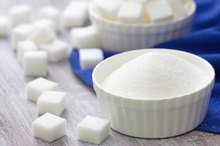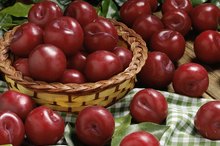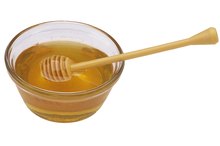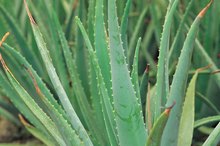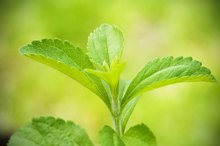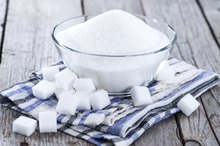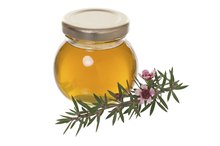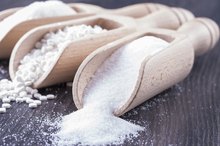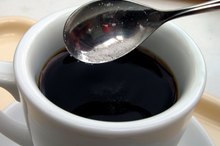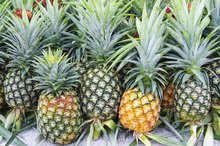High-Fructose Corn Syrup vs. Honey
High fructose corn syrup and honey are both sweeteners that help make foods more appealing to taste 2. High Fructose Corn Syrup, or HFCS, has been used as a sweetener in soft drinks, candy and other packaged and produced food items, while honey is naturally produced by bees and has been used by various cultures as a sweetener for thousands of years 2. Both have similar metabolic structures and contain fructose, but many differences have individuals wondering which is safe to use and have in their homes.
Sugar Explained
Sugar has a specific chemical makeup and can be classified as a monosaccharide, a disaccharide, which is a compound made up of two monosaccharides or a polysaccharide, which is multiple compounds linked together. Most of the sugars that are used in cooking and baking come from sugar cane or sugar beet. Sugar cane is milled and refined into table sugar also known as sucrose and is a monosaccharide. Sugar beet is mostly used in syrups and beverages but still contains high concentrated levels of sucrose. Sucrose, fructose and glucose are the main molecules found in most sweeteners along with lactose and maltose that are found in milk products.
- Sugar has a specific chemical makeup and can be classified as a monosaccharide, a disaccharide, which is a compound made up of two monosaccharides or a polysaccharide, which is multiple compounds linked together.
- Sugar cane is milled and refined into table sugar also known as sucrose and is a monosaccharide.
Chemical Makeup
Dextrose Vs. Fructose
Learn More
Honey is 82% sugar and the rest mostly being water. Of the 82% that is sugar, 43% is glucose and 50% is fructose. HFCS roughly contains 55% fructose and 42% glucose. Both then have small amounts of sucrose and other trace ingredients that complete the chemical makeup. This breakdown shows that honey and high fructose corn syrup both have similar chemical structures and are nutritionally the same.
- Honey is 82% sugar and the rest mostly being water.
- Of the 82% that is sugar, 43% is glucose and 50% is fructose.
History of High Fructose Corn Syrup
Due to the growing popularity of sweet treats and candy, manufacturers created HFCS to cut costs and increase profits. Developers took sucrose molecules and broke them apart into separate glucose and fructose molecules. Fructose is much sweeter then glucose and sucrose so it allowed manufacturers to use less sugar while giving their products more sweetness.
Misconceptions
Natural Fructose Vs. Artificial Fructose
Learn More
There have been developments and claims stating that HFCS poses great threats to personal health, including increased risks of obesity, diabetes, heart disease and other illnesses. Studies done by the USDA and American Dietetic Association show fructose is the main source for health concerns, not HFCS. Large amounts of fructose can lead to high levels of lipids or fats in the blood, also known as hyperlipidemia, as well as increased risks of obesity, diabetes and heart disease.
Considerations
Honey and HFCS are similar in nutritional structure and both can pose great threats to health if not used in moderation. One should consider reducing the use of HFCS as well as all sweeteners, including honey. Make sure your diet is full of fresh fruits and vegetables that are naturally sweet. Keep sugared cereals, snacks and treats to a minimum in your pantry and focus on getting plenty of exercise. Remember that balance and moderation are vital in every aspect of your life, including the sweeteners you find in your cupboard.
- Honey and HFCS are similar in nutritional structure and both can pose great threats to health if not used in moderation.
Related Articles
References
- U.S. Department of Agriculture: Nutrient Data Laboratory
- Science Based Medicine: High Fructose Corn Syrup-Tasty Toxin or Slandered Sweetener?
- Greenfudge.org: Sugar vs. High Fructose Corn Syrup: Which is Better or Worse for You?
- Elliott SS, Keim NL, Stern JS, Teff K, Havel PJ. "Fructose, weight gain, and the insulin resistance syndrome." Am J Clin Nutr. 2002 Nov;76(5):911-22. http://ajcn.nutrition.org/content/76/5/911.full.
- Forshee RA, Storey ML, Allison DB, Glinsmann WH, Hein GL, Lineback DR, Miller SA, Nicklas TA, Weaver GA, White JS. "A critical examination of the evidence relating high fructose corn syrup and weight gain." Crit Rev Food Sci Nutr. 2007;47(6):561-82. http://www.tandfonline.com/doi/abs/10.1080/10408390600846457.
- Parks EJ, Skokan LE, Timlin MT, Dingfelder CS. "Dietary sugars stimulate fatty acid synthesis in adults." J Nutr. 2008 Jun;138(6):1039-46. http://jn.nutrition.org/content/138/6/1039.
- Sievenpiper JL, de Souza RJ, Mirrahimi A, Yu ME, Carleton AJ, Beyene J, Chiavaroli L, Di Buono M, Jenkins AL, Leiter LA, Wolever TM, Kendall CW, Jenkins DJ. "Effect of fructose on body weight in controlled feeding trials: a systematic review and meta-analysis." Ann Intern Med. 2012 Feb 21;156(4):291-304. http://www.ncbi.nlm.nih.gov/pubmedhealth/PMH0034296/.
- Sonestedt E, Overby NC, Laaksonen DE, Birgisdottir BE. "Does high sugar consumption exacerbate cardiometabolic risk factors and increase the risk of type 2 diabetes and cardiovascular disease?" Food Nutr Res. 2012;56. doi: 10.3402/fnr.v56i0.19104. http://www.ncbi.nlm.nih.gov/pmc/articles/PMC3409338/.
Writer Bio
Sarah Horne has been writing since 2009 and is currently Salt Lake City's Moms Fitness Examiner. She works in corporate wellness and is the owner of Yofit, a women's fitness clothing line. Horne received her bachelor's degree in human performance management from Weber State University in 2007, and is a certified health and fitness specialist through ACSM.
